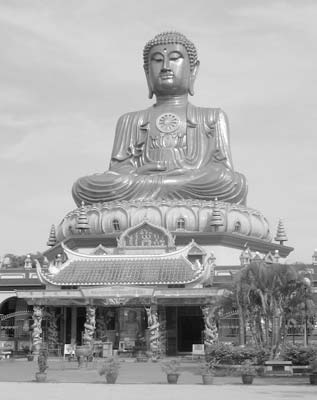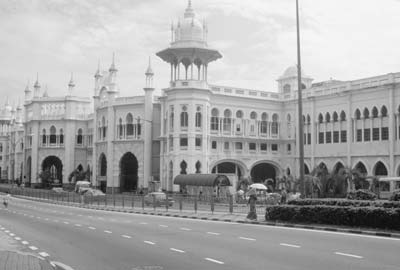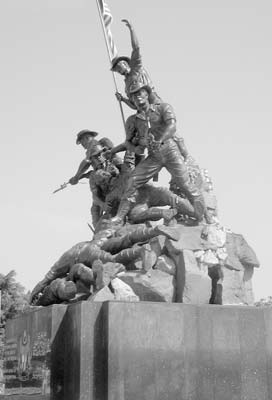Visit Malaysia Year 2007
by Jay Brunhouse
When I arrived in Kuala Lumpur for 2006’s Citrawarna Malaysia (Colors of Malaysia) bash, I was happy to see that the grand old “Arabian Nights” train station was still standing. Moreover, it had a recent coat of white paint. It was undeniably dusty but glistening with architectural charm.
Everyone, except for the tourist brochures, calls Kuala Lumpur “KL.” The brochures call Malaysia’s capital city the “Garden City of Lights,” but, more than anything, KL is a fantasy for anyone charmed by architecture.
Near the turn of the last century the British formulated a plan to construct KL’s public buildings in Renaissance architecture, but because Malaya, as the colony was called, was largely Muslim, London planners considered that something Arabian might be more appropriate.
The British set about building the 1891 train station and fitted it with exotic domes, minarets, Islamic archways, multicolored bricks and spiraling staircases that would make a sultan envious. Its sweeping arches and minarets make it one of the most eye-catching and distinctive in the world.
The product has as much to do with Malaysian Islamic architecture as does a Gothic cathedral, but the British-designed Late Marzipan structures are architectural wonders. They simply are not building them like this anymore.
London authorities initially would not approve its design when analyses showed it would not meet specifications requiring that the roof be able to withstand the weight of three feet of snow.
Transportation hub
Trains of the Malaysian Railways (www.ktmb.com.my) have been diverted to new Sentral Station, KL’s architecturally barren transportation hub, beside extensive networks of elevated commuter trains, but it is encouraging that the Eastern & Orient Express luxury trains call at the old Arabian Nights station in the night on their runs between Singapore and Bangkok.
For modern Islamic architecture, KL is proud of its 88-story Petronas Twin Towers, which topped out in 1996 with a floor plate based on geometric patterns common in Islamic architecture. It is composed of two rotated and superimposed squares with small circular infills.
KL also features the KL Tower, with a rotating restaurant atop the world’s fourth-tallest communications tower. Also, KL’s 2-story Art Deco Central Market is a marvel if you are interested in shopping for batik, puppets, designer Malaysia clothing, and collectables from Kelantan to Sarawak. The building won the Coronation Architectural Design Award in 1953.
Colors of Malaysia
Some 4,000 young dancers, jugglers, flag wavers, precision marchers, drummers and other band members dressed in colorful local costumes launched Citrawarna Malaysia 2006 under glaring television lights presided over by Their Majesties the King and Queen of Malaysia.
One after another attractive song-and-dance troupe dressed in native costumes bright with primary colors paraded like a loud, Technicolor caterpillar along the one-mile-long route. Reds, yellows and blues spellbound their majesties for nearly three hours and fully awed the 238 members of the media from 30 countries who clapped, cheered and hollered from the grandstand.
The cultural dance troupes representing ethnic Malays, Chinese, Indians, tribal groups (Malaysia is 61% Malay, 30% Chinese, 8% Indian and 1% “other”) plus each of the Malaysian states and federal territories aroused enthusiastic applause. Fireworks closed the festivities on the Merdeka Square facing the Renaissance parliament buildings, and media guests left to pack their suitcases for tours to Malacca and Terengganu.
This year is set to be a memorable year to visit Malaysia. The country will be celebrating 50 years of nationhood during “Visit Malaysia 2007.”
Malacca
I had always wanted to visit Malacca (Melaka) because of its reputation, and history, and piracy. I expected to see traces of Malacca’s past in its buildings, monuments and characteristic Portuguese architecture.
In the 16th century, Malacca was the leading trading center in Southeast Asia. Traders came from Arabia, China, India and Europe to make fortunes from silk, spices, gold and porcelain. Successive Portuguese, Dutch and British worthies governed Malacca until the Federation of Malaya achieved independence and was formed on Aug. 31, 1957.
I found a sprawling city with landmark buildings, a core of charming streets and nostalgic architecture, and dramatic rows of decaying 2-story buildings, which sorely need renovation but nevertheless form a peasant picture. I found fine churches, Tamil Indian temples, synagogues and mosques showing the marks of the Malays, Chinese and Tamils from South India.
Idlers and the few tourists gather in the center of Malacca at the Dutch Square with the Queen Victoria Fountain in front of the Stadthuys, which is the former residence of Dutch governors, and, adjacent, the bright red Dutch Christ Church that became an Anglican church when the British arrived.
Leaving KL International Airport, we flew via Malaysia Airlines domestic flight to Kuala Terengganu where we visited Pasar Payang, the Central Market.
Pasar Payang is a “must see,” especially for the first-time visitor to the turtle state. It astonishes visitors with piles of bizarre vegetables, bins filled with mysterious aromatic spices, tables covered with red and green chilies, sausages that look like snakes, and corners filled with exotic foodstuffs.
Terengganu is also known for a thriving batik industry, but a lack of infrastructure has hindered development of the fundamentalist Muslim state despite vast oil and gas resources. Of Malaysia’s states, it remains one of the least developed and ranks second lowest for investments in manufacturing.
From the city, we went by van to the fishing village of Merange in order to board the launch that took us across 25 miles to Redang Island and the Berjaya Redang Beach Resort, which lies at a pearly white-sand beach. There visitors arranged snorkeling and scuba diving in crystal-clear waters rich with marine life, as well as jungle trekking, boating and canoeing.
The resort staff is friendly, the service good, the food excellent and the massages invigorating.
Many thanks
I thank the Malaysia Tourist Board in Los Angeles (213/689-9702, www. tourismmalaysia.com) for inviting me to Citrawarna Malaysia and post tours.
In KL, I stayed at the suburban Boulevard Hotel (phone +603-2295 8000 or log onto www.kl-hotels.com/boulevard), with rates from $57; in Malacca at the boutique Hotel Purim (+606-282 5588, www.hotelpuri.com), from $57; in Kuala Terengganu at the Primula Beach Resort (phone +609-623 3360, www.primulaparkroyal.com), from $60; on Redang Island at the Berjaya Redang Beach Resort (phone +609-630 8866, www.berjayaresorts.com/beachresort_redangbeach.htm), from $54, and in Kota Bharu at the 5-star Renaissance Kota Bharu (phone +609-746 2233, marriott.com/propert/propertypage/KBRER), from $60 double.
I flew Malaysia Airlines (800/552-9264, www.malasiaairlines.com), which gave superior service in the face of a flight delay caused by a typhoon in Taipei. The airline also offers Northwest Airlines frequent-flyer miles.



